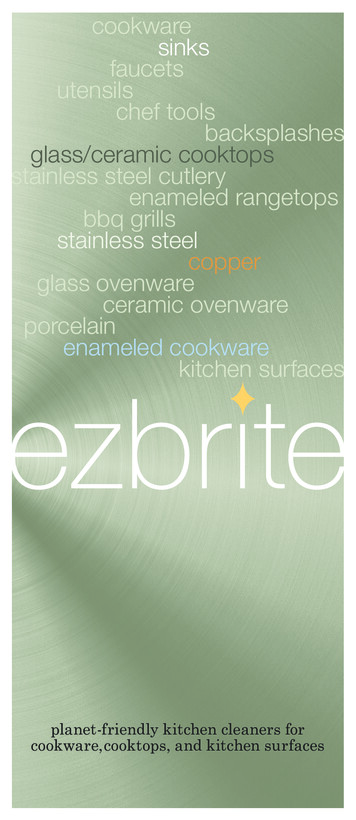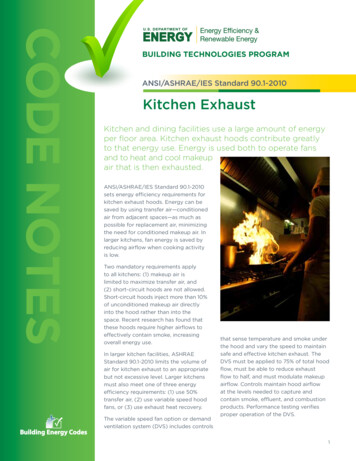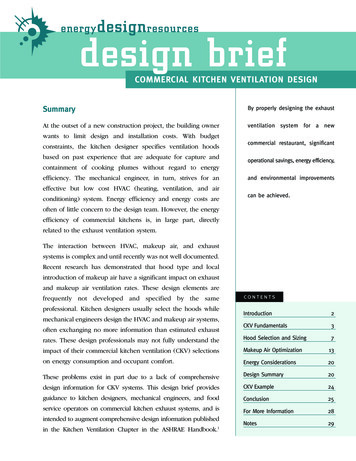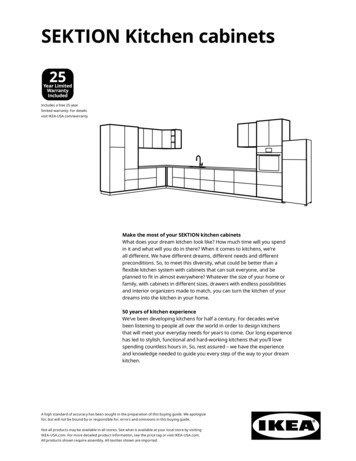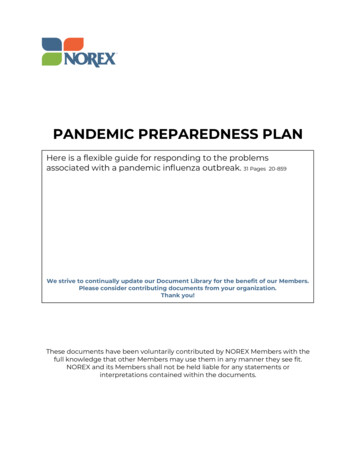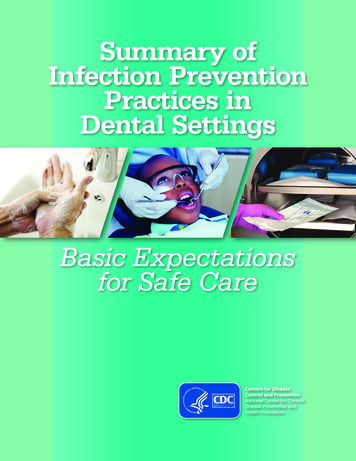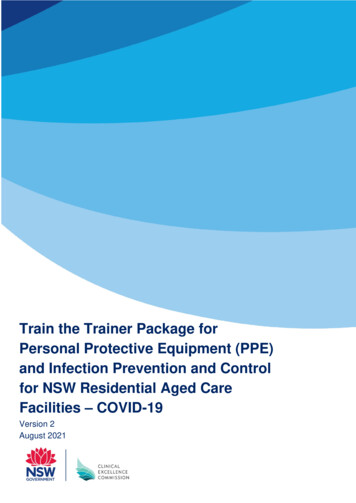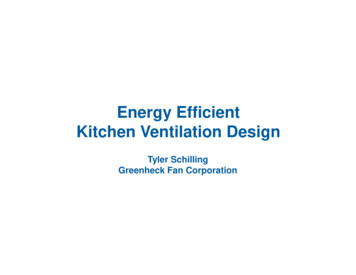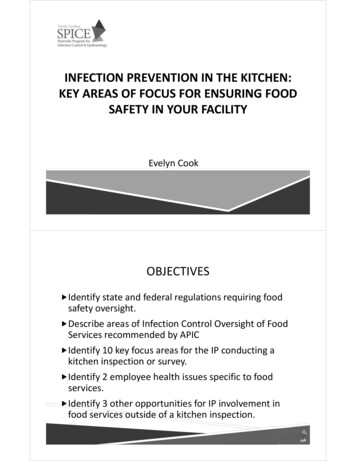
Transcription
INFECTION PREVENTION IN THE KITCHEN:KEY AREAS OF FOCUS FOR ENSURING FOODSAFETY IN YOUR FACILITYEvelyn CookOBJECTIVES Identify state and federal regulations requiring foodsafety oversight. Describe areas of Infection Control Oversight of FoodServices recommended by APIC Identify 10 key focus areas for the IP conducting akitchen inspection or survey. Identify 2 employee health issues specific to foodservices. Identify 3 other opportunities for IP involvement infood services outside of a kitchen inspection.
APIC RECOMMENDATIONS Standards for purchasing and receiving food Maintain clean and functional work areas IPC Oversight of policies and procedures Cleaning, disinfection, and sanitation practices Compliance with local health department regulations Infection Prevention and Control education for staffIP KITCHEN INSPECTION: 10 KEY AREAS AT AGLANCE1. Receiving and storage areas are clean and organized2. Workspaces and preparation areas are clean3. Equipment is clean and properly maintained4. Food is stored in ways that prevent crosscontamination5. Fridge and freezer logs are complete and action plansare present on those that have out of range entries6. Staff are able to demonstrate HACCP procedures fortesting and evaluating safety of food
IP KITCHEN INSPECTION: 10 KEY AREAS AT AGLANCE7. Safety measures for serving food are clearly visible8. No apparent evidence of cross contamination in kitchenworkflow9. Life safety and staff hygiene equipment is clearly labeledand functional10. Staff are visibly healthy and can speak to work restrictionrequirementsSTORAGE AND RECEIVING Containers and waste boxes are broken downand disposed of quickly Food storage areas are clean with items notfound within 6 inches from floor and 18 inchesfrom ceiling Food is inspected and approved when it isbrought into the facility. Ensure logs of testing are kept and staff know criteria foraccepting and rejecting product to prevent problems fromintrinsic contamination.
PREVENTING CROSS CONTAMINATION ANDHAZARDOUS TEMPERATURES Facility refrigerators and freezers are at properlymonitored with complete logs. Out of range temperatures have documentation ofaction. Cooked foods must be stored above raw foods Raw animal foods should be separated from rawready to eat foods during storage, preparation,holding, and display All foods should be properly wrapped or covered
PROPER FOOD STORAGE TEMPERATURES Cold food must be refrigerated to keep temperature less than5 C (41 F) Frozen food must remain frozen at ‐18 C (0 F)AVOID THE DANGER ZONE (70 F – 125 F)Cooked food must be cooled from 135 F to 41 F within 6 hours 135 F ‐ 70 F in 2 hours (rapid cool) 70 F – 41 F in 4 hours
Each item labeledand properlycovered for coldstorageNo raw uncookedanimal foods storedwith ready to eatfoodsFOOD SAFETY PROCEDURES Staff thoroughly wash all raw unprocessed fruits andvegetables under running water before use Staff discard any food that comes out of brokenpackages or swollen cans or has an abnormalappearance or odor. Foods are cooked and held at proper temperatures Individual portions of food once served are discarded. Unwrapped foods are protected with sneeze guards. Single service articles are discarded after one use.
FINAL COOKING TEMPERATURES Steaks and Roast Beef ‐ 130 F or above/customer request Raw Fish, Seafood, and Eggs ‐ 140 F or above Uncooked Pork ‐ 150 F or above Raw Ground and Tenderized Meat ‐ 155 F or above Raw Poultry, Stuffing ‐ 165 F or above
FOOD HOLDING TEMPERATURES Steam Tables Maintain hot foods at 135oF or above. Should not be used to warm foods. Cold Tables Maintain cold foods at 41oF or lower. Should not be used to refrigerate foods.HACCP SAFETY MEASURES FOR SERVING Visualize that prepared food is transported to other areas inclosed food carts or covered containers within proper time limit. Observe that food is served with clean tongs, scoops, forks,spoons, spatulas, or gloves to avoid direct contact with food. When checking temperatures on foods ensure thatthermometers are cleaned appropriately before and after temp. Ask how foods prepared to be served at a later time are cooked,chilled, and reheated. Staff should be interviewed on process for cooling potentiallyhazardous foods (i.e. use of blast chiller)
Food at service countercovered and labeled for timeto discard.CLEAN AND PROPERLY MAINTAINED EQUIPMENT Color coded cutting boards are used then washed and sanitizedin between uses Clean equipment not in use is covered. All food grinders, choppers, and mixers should be taken apart,cleaned, sanitized, completely dried, and reassembled aftereach use. Dishwashers should be drained and flushed daily. Make sure itmaintains a final sanitizing rinse of 180 F and wash water of150 F The exterior of the ice machines are cleaned daily. All serving carts are sanitized. Ensure carts that collect soiledtrays are sanitized as well.
Looks clean ata glance butlook moreclosely toensure all partsof machinesare cleanedClean equipmentstored away fromfood. Color codedcutting boards.Look up under the hood to inspect forgreaseCovered clean equipment not in use
Automatic Washer‐150 F wash for 20s, 180 F rinse for 10s3‐SINK METHOD OF MANUAL WAREWASHING AND SANITIZINGDiagram Courtesy of Wellington‐Dufferin‐Guelph Public Health www.wdghu.orghttp://www.wdgpublichealth.ca/?q node/435
HEALTH OF FOOD SERVICE STAFF All food services employees must be free of active or communicablediseases (skin lesions, boils, gastrointestinal or respiratory infection)and able to speak to procedure for refraining from work if theybecome sick. Food Handlers with diarrhea must be removed from duty until theyare asymptomatic. Individuals identified as chronic carriers of salmonella or shigella arenot permitted to work in food services. Ensure that your facility and/or contracted service has an InfectionControl Employee Health Services Policy that defines which illnessesprohibit staff from working and the process for returning to work.SAFETY OF FOOD SERVICE STAFF There must be a clear distinction of hand washing sinksversus food preparation sinks.
A KITCHEN INSPECTION IS NOT THE ONLYIMPORTANT PIECE Education Collaboration with Food Services Management Formal oversight process Risk Assessment and reporting to Infection Control Committee Performance Improvement /Continuous ReadinessMindset IPC inspections provide Food Services staff with goodopportunity to practice for regular CDPH inspections Consistency of policies and proceduresTIPS FOR IPC EDUCATION FOR FOODSERVICES STAFF Educate Food Services Staff Upon Hire Annually As needed based on survey or assessment results Tailor IPC material to Food Services Staff – focus onrationale for preventative steps Discuss basic general principles of IPC as they relate topatient food services Hand Hygiene Cleaning and Disinfection Standard Precautions
TIPS FOR STRENGTHENING POLICIES ANDPROCEDURES Incorporate food services specific issues in policies Care and Maintenance of Vending Machines / Ice Machines Ensure food handling policies are consistent with facilityIPC principles and policies Ensure policy for restriction of ill food service workers isincorporated into EHS and IPC policy Ensure facilities has proper policy for care andmaintenance of food services equipmentIMPORTANT LINKSFDA Food ailFoodProtection/FoodCode/default.htmHACCP Guidelines – FDA Food Guide Annex FoodProtection/FoodCode/ucm089302.htm
QUESTIONS .FOODSAFETYFOREVERYONE
May 09, 2017 · APIC RECOMMENDATIONS Standards for purchasing and receiving food Maintain clean and functional work areas IPC Oversight of policies and procedures Cleaning, disinfection, and sanitation practices Compliance with local health department regulations Infection Prevention and Control education f
